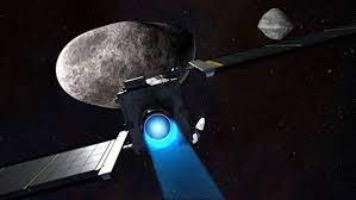
Amid all the problems taking place around the world with the likes of the war in Ukraine; climate change; the on-going Covid-19 pandemic; and the deteriorating marine ecosystem; amongst others, many will be forgiven for missing potentially one of the most important items of news which was successfully completed on 26 September, and should be of interest to everyone across the globe.
Launched on 24 November 2021, NASA’s 1,260-pound Double Asteroid Redirection Test spacecraft, or DART as it has become better known, accomplished its mission some seven million miles above the earth, which was a test to see if an asteroid could be knocked off its orbit. If such a body were ever to be hurtling towards our planet at some time in the future, the knowledge gained from this could effectively save mankind.
Target Dimorphos
This particular asteroid, given the name Dimorphos, is in actual fact a moon orbiting a 2,500-foot-wide genuine asteroid, named Didymos. Neither of these two pose the slightest threat to Earth, but the smaller of the pair offered scientists the perfect target for the $330-million DART mission, because the effects of the probe’s impact could be measured from Earth, to establish orbital changes following the collision.
In extremely rare events when an asteroid’s path around the Sun crosses that of the Earth, it is possible for an impact to occur and obviously the larger the space rock, the greater the devastation. Hence the commissioning of the project, which saw a Falcon 9 rocket carrying the $325m DART spacecraft blast off last November, from Vandenberg Space Force Base in California.
Why the need for such a test?
Dimorphos was chosen because if an object of similar dimensions were to ever be on a collision course with our planet, it would explode with many times the energy of a typical nuclear bomb, devastating populated areas and causing tens of thousands of casualties. Anything considerably bigger could cause continent-wide destruction, while those bigger than 1km would produce worldwide effects and probably mass extinctions.
Kinetic impactor technique
After escaping Earth’s gravity, DART followed its own orbit around the Sun, before intercepting the asteroid as it approached within 6.7 million miles of Earth. It carried onboard a camera called Draco that provided images of both of the asteroids and helped to point the spacecraft in the correct direction to effect a collision, which is referred to as the kinetic impactor technique. There was a degree of uncertainty over how Dimorphos would respond to the impact, in part because its interior structure is not known.
Seven times faster than a fired bullet
Hurtling along at a bewildering 14,000 mph, DART was beaming back images of Dimorphos once per second. It came in to sight around an hour prior to impact, still 15,000 miles away. Then, covering the final 1,000 miles in less than four minutes, and travelling at seven times the speed of a bullet, the spacecraft’s camera captured the target growing larger and larger, from a dim point of light until it filled the entire field of view.
Impact
Transmissions ceased momentarily on impact as DART slammed into Dimorphos, disintegrating immediately and blasting out a fresh crater in the rocky surface. Initial calculations suggest the impact was a mere 17m off the exact centre of Dimorphos, which is simply staggering. At that moment, after many years of incredible planning and a 10-month voyage from Earth, flight controllers erupted in cheers and applause as their project completed its assignment to perfection.
Elena Adams, DART mission systems engineer at the Johns Hopkins University Applied Physics Laboratory, who helped oversee the spacecraft’s final moments, was heard to exclaim: “Oh my goodness, look at that, it’s unbelievable!” In that moment, proof was established, that if the time ever came, it would be very possible to save our planet from total destruction.
Hitch-hiker records images
Ten days before the impact, DART had released what was known as a small “Italian hitch-hiker spacecraft” called LICIACube, to photograph the collision and the debris that was blasted back out into space, travelling a safe distance to the rear. Those images were stored on board and will be relayed back to Earth sometime later.
NASA science chief Thomas Zurbuchen who was unsurprisingly upbeat afterwards, said in a statement. “Now we know we can aim a spacecraft with the precision needed to impact even a small body in space.” He added that planetary defence is a globally unifying effort which affects every single person and indeed creature, living on Earth.
Scientists to re-calculate effect of collision
Scientists will now measure slight changes in the combined reflected light from both asteroids. In the period before impact they had cleverly calculated that one orbit of Didymos took 11 hours and 55 minutes, by timing how the light dims and brighten. They can now repeat the exercise and their post-collision observations will allow them to determine what the actual effects DART has had, with early estimates believing it could be by around 10 minutes.
It will take a few days to a few weeks for telescopes around the world and in space, including the Hubble and James Webb space observatories, to make accurate measurements.
Achievement put into perspective
To get some perspective on the extraordinary accuracy achieved by these amazingly talented people, the size of DART is just under 5 times smaller than the Statue of Liberty, which itself is half the size of the asteroid Dimorphis, that in turn is around half the size of the Eiffel Tower. The asteroid Didymos is a little over twice the size of the famous French landmark. These are the astonishing accuracies that the scientists were able to direct into making such a monolithic discovery.
Objectives reached
This effectively was a test for a test, without the anxiety of the real thing. However, they knew the outcome would be far reaching. The two major objectives were satisfied. Firstly the ability to build an autonomously guided spacecraft that could achieve the kinetic impact on an asteroid; and secondly discover how the asteroid responded to the impact.
Follow up studies
The plan is for three spacecraft, collectively known as the Hera mission, to make follow up studies at Didymos and Dimorphos, around four years from now, so the European Space Agency (ESA) stated.
In blockbuster Hollywood movies, hero’s pilot crafts to use nuclear bombs to destroy similar targets, but in reality something along that storyline couldn’t really happen, and deflection and not destruction would have to be the course of action.
Having the capability to nudge a deadly space rock out of harms way, is quite remarkable and an achievement that probably will go unnoticed in most corners of the world, but should be recognised as one of the great discoveries of recent times.
Mick the Ram












0 Comments